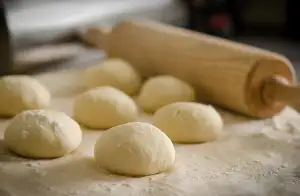Master the Art of Making Pasta: Step-by-Step Instructions for Culinary Bliss

- Gathering the essential ingredients for homemade pasta
- Mixing and kneading the pasta dough to perfection
- Resting the dough for optimal texture and elasticity
- Rolling out the pasta dough with precision and care
- Cutting and shaping the pasta into desired forms
- Cooking the pasta to al dente perfection
- Pairing the pasta with delectable sauces and toppings
- Serving and enjoying the homemade pasta masterpiece
Pasta, a staple in Italian cuisine, has captivated food lovers around the world with its versatility and comforting flavors. Making pasta from scratch is not only an art form but also a labor of love. It allows you to create a culinary masterpiece that is uniquely yours. From the moment you gather the ingredients to the final presentation on your plate, each step in the process is an opportunity to express your creativity and passion for food. Join us on this journey as we delve into the secrets of mastering the art of making pasta, and unlock a world of endless possibilities in your kitchen. Get ready to embark on a delicious adventure that will elevate your cooking skills and bring joy to your taste buds.
Gathering the essential ingredients for homemade pasta
When it comes to making homemade pasta, the first step is gathering the essential ingredients. While there are countless variations of pasta recipes, the basic ingredients remain the same. To create a delicious and authentic pasta dough, you will need just three simple ingredients: flour, eggs, and salt.
Choosing the right type of flour is crucial for achieving the perfect texture and flavor in your pasta. Traditional Italian pasta is made with durum wheat flour or semolina flour, which gives it a slightly yellow color and a firm bite. If these flours are not readily available, all-purpose flour can be used as a substitute.
Next, you will need fresh eggs to bind the dough together. The number of eggs required depends on the quantity of pasta you wish to make. As a general rule of thumb, use one egg per 100 grams of flour. It's important to use fresh eggs at room temperature for optimal results.
Lastly, don't forget to add a pinch of salt to enhance the flavor of your pasta dough. This small addition can make a big difference in taste.
By gathering these essential ingredients beforehand, you'll be well-prepared to embark on your journey towards mastering the art of making homemade pasta.
Mixing and kneading the pasta dough to perfection
Mixing and kneading the pasta dough is a crucial step in achieving the perfect texture and consistency. Start by creating a well in the center of your flour mound, then crack the eggs into it. Gently beat the eggs with a fork, gradually incorporating the flour from the edges. Once a shaggy dough forms, use your hands to bring it together.
Knead the dough for about 10 minutes until it becomes smooth and elastic. This process helps develop gluten, giving the pasta its desired chewiness. Apply firm pressure with the heel of your hand, folding and turning the dough as you go. If it feels too dry, sprinkle some water; if too sticky, add a bit more flour.
The key is to achieve a dough that is neither too wet nor too dry. It should be soft and pliable but not stick to your hands or work surface excessively. Remember to be patient and avoid rushing this step as proper kneading ensures a uniform texture throughout the pasta.
Once you've achieved a smooth consistency, shape the dough into a ball and cover it with plastic wrap or a damp cloth. Allow it to rest for at least 30 minutes before rolling it out. This resting period allows gluten strands to relax and results in easier rolling later on.
Now that you have mastered mixing and kneading, you are one step closer to creating homemade pasta that will impress even the most discerning palates. So roll up your sleeves and let's move on to the next stage: resting the dough for optimal texture and elasticity.
Resting the dough for optimal texture and elasticity
Resting the dough is a crucial step in the pasta-making process that allows the gluten to relax and develop, resulting in a tender and elastic texture. After kneading the dough, cover it with a clean kitchen towel or plastic wrap and let it rest for at least 30 minutes. This resting period allows the flour to fully hydrate and ensures that the dough will be easier to roll out later. During this time, the proteins in the flour will absorb moisture, creating a more pliable dough that is less likely to tear or become tough when cooked. So be patient and let your dough rest, as it is essential for achieving optimal texture and elasticity in your homemade pasta.
Rolling out the pasta dough with precision and care
Rolling out the pasta dough is a crucial step in achieving the perfect texture and thickness for your homemade pasta. After allowing the dough to rest, lightly flour your work surface and divide the dough into manageable portions. Take one portion and flatten it with your hands, then use a rolling pin to begin rolling from the center outward. Apply even pressure as you roll, rotating the dough occasionally to ensure an even thickness. Aim for a thin and uniform sheet of pasta that is translucent enough to see your hand through. Be patient and take your time, as rushing this step can result in unevenly rolled pasta. With precision and care, you'll soon have a beautiful sheet of pasta ready for cutting and shaping into your desired forms.
Cutting and shaping the pasta into desired forms
Once you have rolled out your pasta dough to the desired thickness, it's time to cut and shape it into the forms that will make your dish truly unique. There are countless options for cutting and shaping pasta, allowing you to unleash your creativity and personalize each dish.
For long pasta shapes like spaghetti or fettuccine, use a sharp knife or a pasta cutter to slice the dough into thin strips of your desired width. To create more intricate shapes like farfalle (bow-tie) or tortellini, you can use specialized tools or simply cut small squares or circles from the dough and fold them in various ways.
If you prefer filled pasta like ravioli or agnolotti, place dollops of your chosen filling onto one sheet of rolled-out dough, leaving space between each dollop. Then, carefully place another sheet of dough on top and press down around each filling mound to seal them together. Use a ravioli cutter or a sharp knife to cut out individual pieces.
Remember to dust the cut pasta shapes with flour to prevent sticking as you work. And don't worry if they're not all perfectly uniform – homemade pasta has a rustic charm that adds character to any dish.
Experiment with different shapes and sizes until you find what suits your taste and style best. The possibilities are endless! Once you've mastered the art of cutting and shaping pasta, you'll be able to create visually stunning dishes that will impress even the most discerning palates.
Cooking the pasta to al dente perfection
Cooking the pasta to al dente perfection is a crucial step in the art of making pasta. Al dente, meaning "to the tooth" in Italian, refers to pasta that is cooked just enough to retain a firm texture while still being tender. Achieving this delicate balance requires careful attention and precise timing.
To cook the pasta al dente, bring a large pot of salted water to a rolling boil. The general rule is to use one gallon of water for every pound of pasta. This ensures that the pasta has enough space to cook evenly and prevents it from sticking together.
Once the water reaches a vigorous boil, carefully add the homemade pasta. Stir gently with a wooden spoon to prevent sticking and ensure even cooking. Cooking times may vary depending on the thickness and shape of the pasta, so refer to the package instructions as a general guideline.
Keep a close eye on the pasta as it cooks, testing its doneness periodically by taking a small piece and tasting it. Al dente pasta should offer some resistance when bitten into but should not be hard or crunchy in the center.
When you are satisfied with the texture, immediately drain the cooked pasta using a colander or slotted spoon. Be sure not to rinse it with water, as this removes starches that help sauces adhere to the noodles.
Now your perfectly cooked al dente pasta is ready to be paired with delectable sauces and toppings. Whether you prefer classic marinara, creamy Alfredo, or vibrant pesto, your homemade masterpiece will be elevated by its perfectly cooked foundation.
Remember, mastering the art of cooking pasta al dente takes practice and experimentation. With time and experience, you will develop an intuition for achieving that perfect balance between tenderness and firmness in every bite.
Pairing the pasta with delectable sauces and toppings
Pairing the pasta with delectable sauces and toppings is where the true magic happens. The possibilities are endless, allowing you to unleash your creativity and tantalize your taste buds. For a classic Italian touch, toss freshly made spaghetti with a rich tomato sauce, garnished with fresh basil and a sprinkle of Parmesan cheese. Or, for a creamy indulgence, pair fettuccine with a velvety Alfredo sauce, topped with sautéed mushrooms and crispy bacon. If you're feeling adventurous, experiment with pesto, carbonara, or even a spicy arrabbiata sauce. Don't forget to add some texture and flavor with ingredients like toasted pine nuts, roasted vegetables, or succulent grilled shrimp. The key is to find the perfect balance of flavors that complement the pasta without overpowering it. So go ahead, let your imagination run wild and create your own signature pasta dish that will leave everyone craving for more.
Serving and enjoying the homemade pasta masterpiece
Serving and enjoying the homemade pasta masterpiece is the final step in the art of pasta making. After all the hard work and dedication, it's time to indulge in the delicious creation. Carefully transfer the cooked pasta to a serving dish, allowing any excess water to drain off. The vibrant colors and enticing aromas will surely captivate your senses. Now, it's time to add the finishing touch - a generous sprinkle of freshly grated Parmesan cheese or a drizzle of extra virgin olive oil. Garnish with some fresh herbs like basil or parsley for an added burst of flavor. Serve alongside a glass of your favorite wine or a refreshing salad for a complete culinary experience. Gather your loved ones around the table and savor each bite, relishing in the satisfaction that comes from creating something truly extraordinary from scratch. Let the flavors dance on your palate as you immerse yourself in this culinary bliss.
In conclusion, mastering the art of making pasta from scratch is a truly rewarding experience. It allows you to unleash your creativity and create dishes that are not only delicious but also visually stunning. The process of gathering the ingredients, mixing and kneading the dough, rolling it out with precision, and shaping it into various forms requires patience and practice. However, the end result is worth every effort.
Creating homemade pasta allows you to control the quality of ingredients used, ensuring a healthier and more flavorful dish. It also gives you the freedom to experiment with different flavors and textures, as well as tailor the pasta to suit your personal preferences.
The joy of making pasta from scratch extends beyond just the cooking process. It brings people together, whether it's sharing the task of rolling out dough or enjoying a meal made with love. The aroma that fills your kitchen as the pasta cooks and the satisfaction of serving a dish that you have created from start to finish are incomparable.
So why not embrace this culinary art form? With practice and determination, you can master the art of making pasta and elevate your cooking skills to new heights. So go ahead, gather your ingredients, roll up your sleeves, and embark on a journey of culinary bliss by creating your very own homemade pasta masterpiece.
Published: 21. 11. 2023
Category: Food



